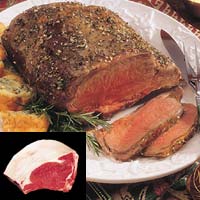Penn Herb Wellness Guide
Beef Rib Roast

Varieties
Rib roast is available either with bones in, called standing rib roast, or boneless, called rolled rib roast.
Small End Rib Roast
Cut from the part of the ribs closest to the loin, this is the most tender half of the rib roast.
Large End Rib Roast
Cut from the part of the ribs closest to the chuck, the large-end roast is slightly less tender than the small end roast.
Rib-Eye Roast
This is a boneless roast cut from a single muscle, the rib-eye muscle. Well-marbled and tender, it is also known as a Delmonico roast, after the New York restaurant that popularized this cut in the mid 1800s.
Copyright 2025 TraceGains, Inc. All rights reserved.
Learn more about TraceGains, the company.
The information presented in the Food Guide is for informational purposes only and was created by a team of USregistered dietitians and food experts. Consult your doctor, practitioner, and/or pharmacist for any health problem and before using any supplements, making dietary changes, or before making any changes in prescribed medications. Information expires December 2025.


